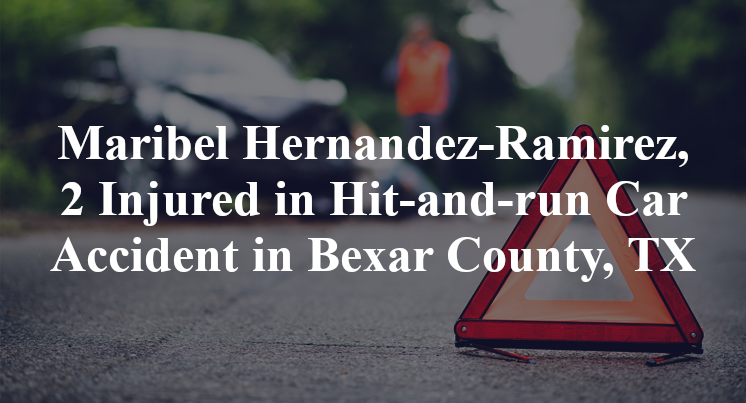Maribel Hernandez-Ramirez, 2 Injured in Hit-and-run Car Accident in Bexar County, TX
Bexar County, TX — July 21, 2024, Maribel Hernandez-Ramirez and two others were injured due to a hit-and-run car accident at about 5:45 p.m. along I-35.
According to authorities, 41-year-old Maribel Hernandez-Ramirez, a 60-year-old man, and a 7-year-old boy were traveling in a northbound Chevrolet SUV on I-35 in the vicinity south of Shepherd Road when the accident took place.

Officials indicate that, for as yet unknown reasons, a northbound Hyundai Accent made an unsafe lane change, causing the Chevrolet to swerve in order to avoid a collision. It apparently veered off of the right side of the road where it overturned, rolling approximately two times before coming to a stop. The Accent allegedly fled the scene, the person(s) inside failing to stop and render aid to the victims. Witnesses apparently helped in getting the license plate of the suspect vehicle.
Hernandez-Ramirez reportedly sustained serious injuries over the course of the accident. The man and 7-year-old suffered minor injuries, as well, according to reports. They were each transported to local medical facilities by EMS in order to receive necessary treatment. Additional details pertaining to this incident are not available at this point in time.
Commentary by Attorney Michael Grossman
When a hit-and-run forces a family’s vehicle off the road and into a rollover, the physical damage is just the beginning. What’s left behind are questions that aren’t easily answered by a citation or a police report—especially when the person who triggered the crash drove away.
1. Did the authorities thoroughly investigate the crash?
Avoidance-related crashes are some of the hardest to reconstruct, particularly when one vehicle never makes contact. That makes it all the more important for investigators to gather statements, check surrounding cameras, and accurately document tire marks and vehicle paths. Did they verify witness accounts with physical evidence? Did they identify where the SUV began its swerve and how far it traveled before rolling? These details help determine whether the swerve was a panic reaction or a forced maneuver—and whether it was truly unavoidable.
2. Has anyone looked into the possibility that a vehicle defect caused the crash?
A sharp swerve followed by a rollover raises questions about vehicle stability systems. Was the Chevrolet SUV equipped with electronic stability control, and did it function as designed? If the vehicle rolled after just a lane departure, that might point to tire, suspension, or steering-related issues that exacerbated the situation. Even if the root cause began with the Hyundai’s unsafe lane change, the response of the SUV could have been worsened by hidden defects—assuming anyone inspected it for those possibilities.
3. Has all the electronic data relating to the crash been collected?
In a crash like this, data from the SUV could reveal whether the driver hit the brakes, how sharply they turned the wheel, and how fast they were going when control was lost. That kind of information can help confirm whether the Hyundai’s move created a no-win situation or whether additional factors were at play. If the fleeing vehicle is eventually found, its data might also hold clues—but those are often lost if no one knows to collect them early.
A hit-and-run may end in seconds, but the effort to understand it has to go further. When a family is hurt and one driver disappears, every missed step in the investigation risks leaving the real story untold.
Takeaways:
- Crash reconstruction should examine swerve origin, path, and whether the maneuver was necessary or avoidable.
- Vehicle stability, steering, and suspension systems should be checked for possible defects or malfunctions.
- Event data from the SUV can help explain how the driver reacted and why the vehicle rolled.

*We appreciate your feedback and welcome anyone to comment on our blog entries, however all visitor blog comments must be approved by the site moderator prior to showing live on the site. By submitting a blog comment you acknowledge that your post may appear live on the site for any visitors to see, pending moderator approval. The operators of this site are not responsible for the accuracy or content of the comments made by site visitors. By submitting a comment, blog post, or email to this site you acknowledge that you may receive a response with regard to your questions or concerns. If you contact Grossman Law Offices using this online form, your message will not create an attorney-client relationship and will not necessarily be treated as privileged or confidential! You should not send sensitive or confidential information via the Internet. Since the Internet is not necessarily a secure environment, it is not possible to ensure that your message sent via the Internet might be kept secure and confidential. When you fill out a contact or comment form, send us an email directly, initiate a chat session or call us, you acknowledge we may use your contact information to communicate with you in the future for marketing purposes, but such marketing will always be done in an ethical way.